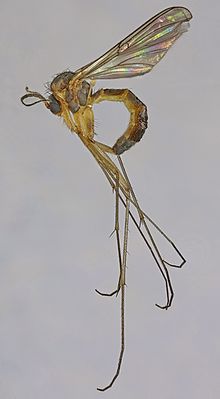
Trametes versicolor – also known as Coriolus versicolor and Polyporus versicolor – is a common polypore mushroom found throughout the world. Meaning 'of several colors', versicolor reliably describes this fungus that displays different colors. For example, because its shape and multiple colors are similar to those of a wild turkey, T. versicolor is commonly called turkey tail. A similar looking mushroom, commonly called false turkey tail, which is from a different order, may sometimes be confused with the turkey tail mushroom due to appearance. Another lookalike is the multicolor gill polypore.
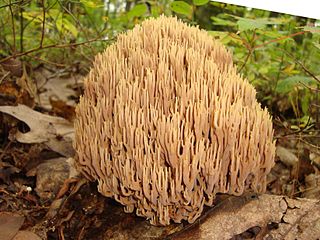
Ramaria stricta, commonly known as the strict-branch coral is a coral fungus of the genus Ramaria. It has a cosmopolitan distribution, and grows on dead wood, stumps, trunks, and branches of both deciduous and coniferous trees. Its fruit body is up to 10 cm (3.9 in) tall, made of multiple slender, compact, and vertical parallel branches. Its color is typically light tan to vinaceous-brown. All parts of the mushroom will bruise when handled. There are several lookalike corals that can usually be distinguished from R. stricta by differences in coloration, bruising reaction, or microscopic features. The fungus is inedible due to its unpleasant odor and bitter taste.

Bolitophila cinerea is a Palearctic species of 'fungus gnat' in the family Bolitophilidae.

Cordyla flaviceps is a Palearctic species of 'fungus gnat' in the family Mycetophilidae.The type-locality is Copenhagen (Denmark). C. flavicepsis a mycetophage associated with Russula and Lactarius.

Diadocidia ferruginosa is a Palearctic species of fungus gnat in the family Mycetophilidae. They live as larvae in long dry silken tubes under bark or in rotten wood and probably feed on fungal mycelia or spores. Also associated with Peniophora.
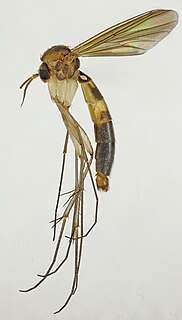
Exechia contaminata is a Palearctic species of fungus gnat in the family Mycetophilidae. Exechia contaminata is chiefly or exclusively associated with Russula and Lactarius.
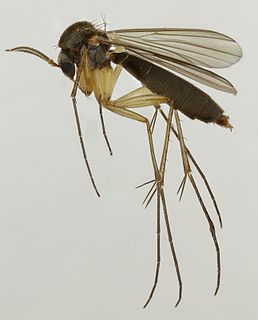
Exechia spinuligera is a Palearctic species of fungus gnat in the family Mycetophilidae. Exechia contaminata is chiefly or exclusively associated with Russula and Lactarius.

Isoneuromyia semirufa is a Palearctic species of 'fungus gnat' in the family Mycetophilidae. The members of this genus [Orfelia] are, as larvae, web spinners chiefly associated with dead wood where they feed on fungal hyphae. They also could be found in turf, grass tussocks, under logs and boulders, in worm tunnels, among mosses and liverworts. They were discovered in 2006 in China: Zhejiang province: Wuyanling National Natural Reserve, Yiping Wang along with 3 Isoneuromyia Isoneuromyia baumhaueri, Isoneuromyia signata and orfelia semirufa
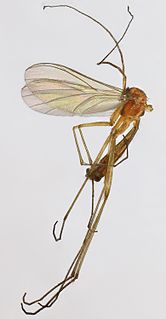
Macrocera parva is a Palearctic species of 'fungus gnat' in the family Keroplatidae.Larvae of species in this genus have been reared from a range of situations including clumps of turf, rotting wood and cave walls and are thought to be predaceous.

Mycetophila edwardsi is a Palearctic species of 'fungus gnat' in the family Mycetophilidae. Mycetophila edwardsi is found in forest or wooded areas where the larvae develop in fruiting bodies of large fungi.

Mycetophila formosa is a Palearctic species of 'fungus gnat' in the family Mycetophilidae. Mycetophila formosa is found in forest or wooded areas where the larvae develop in Phlebia radiata and moist, strongly decayed wood of birch and spruce log bearing Trechispora hymenocystis.

Mycetophila fungorum is a Palearctic species of 'fungus gnats' in the family Mycetophilidae. Mycetophila fungorum is found in forest or wooded areas where the larvae develop in Agaricales and also obtained with emergence traps over dead wood, soil and ground flora.
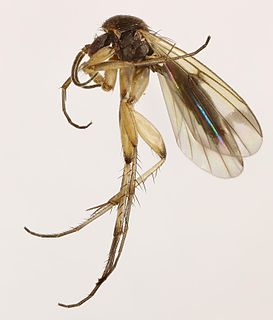
Mycetophila luctuosa is a Palearctic species of 'fungus gnats' in the family Mycetophilidae. Mycetophila luctuosa is found in forest or wooded areas where the larvae develop in Neolentinus lepideus, Kretzschmaria deusta, Chondrostereum purpureum, Sebacina incrustans, Neolentinus tigrinus, Pleurotus spp., Trametes versicolor and a wide range of epigeic fungi, mostly Russulaceae.

Boletina gripha is a Palearctic species of 'fungus gnats' in the family Mycetophilidae. It is found in a wide variety of habitats from wooded streams to wetlands and open moorland. Reared from brown rot of spruce stump, spruce log bearing loose bark and decaying wood of pine. Larvae have been on the surface of decaying wood covered with Resinicium bicolor, from soil in pine forest and from fruiting bodies of Suillus bovinus.

Brachypeza bisignata is a Palearctic species of 'fungus gnat' in the family Mycetophilidae. Reared from puffballs (Lycoperdales).

Boletina trivittata is a Palearctic species of 'fungus gnat' in the family Mycetophilidae. Members of this genus are found in a wider variety of habitats from wooded streams to wetlands and open moorland. Adults have been obtained in emergence traps in a range of situations including rotting wood and soil litter.
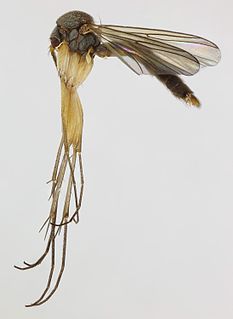
Brevicornu foliatum is a Palearctic species of 'fungus gnat' in the family Mycetophilidae. Members of this genus are found in a wider variety of habitats from wooded streams to wetlands and open moorland. Larvae develop in dead wood and in soil litter, feeding probably on microfungi.
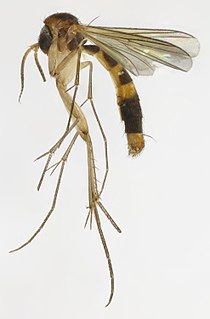
Mycetophilinae is a subfamily of fungus gnats in the family Mycetophilidae. There are more than 30 genera and 2,000 described species in Mycetophilinae.
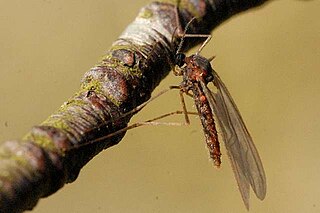
Mycomya is a genus of fungus gnats in the family Mycetophilidae. There are at least 400 described species in Mycomya.
Mycomya imitans is a species of fungus gnats in the family Mycetophilidae.
